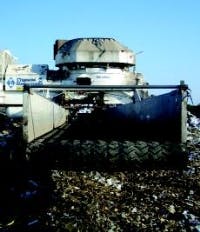The 1600G mobile solid waste grinder, shown here at a landfill in Albany, N.Y., uses a plethora of hydraulics to rip household trash into smaller, more manageable pieces.
View of secondary conveyor on the SWG1600. Hydraulic motors run the belt as fast as 650 fpm.
In recent years, increasing governmental regulations, rising land prices, and the public's "not in my backyard" attitude has added to the strain on the landfill industry. Recycling and diversion programs have had some success in reducing the total waste generation, but the average American still adds more than 4 lb of garbage into the solid waste stream every day.
One way that landfills have been coping with these problems is by the use of a process called municipal solid waste (MSW) grinding. MSW grinding has plenty of benefits to the environment and to the landfills. The process crates smaller, more uniformly sized waste. This helps in reducing ruptures of liners at the bottom of the landfill — and it also means less wear on landfill equipment that drives over the waste. The smaller pieces of waste also decompose faster, due to higher surface area exposed to oxygen. Smaller waste can be packed more tightly into landfills, saving space by as much as 33% over simple dumping, compacting, and spreading with a bulldozer.
In traditional MSW grinding, bulldozers push waste into a storage pit. A loader then picks up bunches of trash and deposits them onto a conveyor system, which carries the trash to a shredding system. However, a newer technology incorporates a mobile tub grinder, saving the expense of transporting waste to and from the grinder and setting up extensive conveyor systems. Diamond Z Mfg., Caldwell, Idaho, manufactures the SWG 1600, an innovative machine that gives landfill operators much more flexibility in grinding waste on site.
Get a move on
The 1600 is a traditional industrial tub grinder designed to handle highly contaminated municipal landfill waste, including construction and demolition materials and household green waste. Normally, a portable tub grinder has a set of three axles and is moved with a tractor rig to the grinding location. The 1600 is equipped with a set of tracks that enables it to navigate independently across the face of a landfill. Amazingly, it can process over 300 tons of waste per hour.
Municipal waste is highly contaminated with stringy, wet, flexible material — as well as steel pipe, canisters, etc. — that quickly packs a traditional screen in a tub grinder. The 1600 uses a series of patented screening rods that can be retracted hydraulically to individual preferences for end product sizing. Additionally, this retracting feature allows rapid cleaning of the mill area at the end of the day, by passing the rods through self-cleaning bolster plates.
Heavy-duty hydraulics
The 1600 is a hydraulic marvel. Nearly every function on the machine has some hydraulic power behind its operation. The tub is driven by two hydraulic motors turning a sprocket and chain arrangement, the tracks are controlled through independent hydrostatic transmissions, and the conveyors are each driven by independent hydraulic motors.
The main operation powered by hydraulics is the material feed system in the rotating tub. Hydraulic motors drive the tub to continuously agitate the material and carry new material over the hammermill a rotating cylinder featuring detachable hammers — to be ground.
The grinding operation happens in the mill area, where the hammermill tips impact the material, breaking and tearing it into smaller pieces. The pulverized material is then pushed past the screening rods in a semi-circular arrangement to further reduce the product to a uniform size. These screening rods are hydraulically retracted for size adjustment and cleaning when material wraps around or becomes lodged in between rods.
Processed material falls onto a 10-ft long primary discharge conveyor, located under the machine. This 66-in. wide belt travels at 500 fpm and discharges into a secondary conveyor that is 50-ft long by 72-in. wide. The hydraulic drive motors produce belt speeds of up to 650 fpm.
The vehicle's tracks are driven independently and are only operational when all grinding operations have ceased. Hydraulic motors on the tracks are capable of moving the 160,000-lb machine at approximately 1.5 mph on an incline of up to 15° off horizontal.
The seven screening rods, used to size material, are extended and retracted with individual 5-in. bore, 96-in. stroke cylinders. The hammermill rod puller uses an additional cylinder for replacing hammermill rods. Landing legs for assembly and disassembly are individually controlled 8-ft stoke cylinders mounted to removable brackets. Tub tilt cylinders lift the tub for hammermill maintenance, and tub locking cylinders secure the tub during grinding for operational safety.
A Voith 650 fluid coupling is used to transmit power from the engine to the hammermill and for severe impact cushioning protection. Even access doors, due to their extreme weight, are lifted with hydraulic cylinders.
In control
The machine is fully remote-controlled through a multi-function touch pad. Grinding functions are locked out while the travel mode is engaged. Once the grinder is properly situated, an operator in an excavator feeds the grinder usinga grapple attachment. The grinder automatically senses the rotating tub pressures if an overload occurs, and reverses the tub to relieve the system until the load is ground out or resituated in the tub. The operator's main function is to try to keep the tub loaded with unground material.
The tracks, tub, conveyors, and screening rods are powered by a 210-hp Detroit Series 40 engine dedicated to auxiliary functions so that the hammermill can have all the power available from either a Detroit 1340-hp engine or a CAT 1650-hp engine.
The remote control system manages all hydraulic functions from the cab of a excavator or loader. A feedback system built into the hydraulic controls senses the loads on the conveyor belts. If the pressure is too great on the motors driving the belts, the controller reduces power to the tub to stop processing material. This allows the belts to catch up and move the material off the conveyor and avoid a backup in the mill area.
With a traditional tub grinder, once the mill area and sizing screens are plugged with material, it is a very labor intense process to unplug them. The 1600 is designed with a removable conveyor cartridge to reduce the time to repair a belt and clean out the mill area. A hydraulically actuated access door opens on the opposite side of the secondary conveyor and the primary conveyor direction is reversed. The screen rods are retracted and the clogging material is scraped off the rods and dropped onto the belt — delivering the material outside the machine for disposal or reprocessing.
The tub motors are controlled by the engine speed sensing in the controller. If the engine is being overloaded, the tub motors pause and reverse at a preset time delay to allow the motor to regain speed.
All grinder and track functions are capable of being controlled manually on the machine as well as by the multi-function remote transmitter.
Conclusion
According to Joe Mason, senior engineer for Diamond Z, "We use steel hydraulic lines as much as possible in the design, to clean up locations and prevent rubbing and improve heat dissipation." Mason also notes that the 1600 uses Parker Hannifin 3000 and 5000 psi high grade rubber hose, selected for its ability to operate in such an extreme environment.
Mason says that fluid power was chosen because, "it is rugged, dependable, and puts the power where it is needed with the fewest parts."
The brutal application of force to pulverize material and the resultant vibration and shock impacts rule out the use of electromechanical devices for most all of the 1600G hydraulic applications.
"Frankly," says Mason, "The overall weight and required mobility of the machine eliminates a lot of alternatives."



